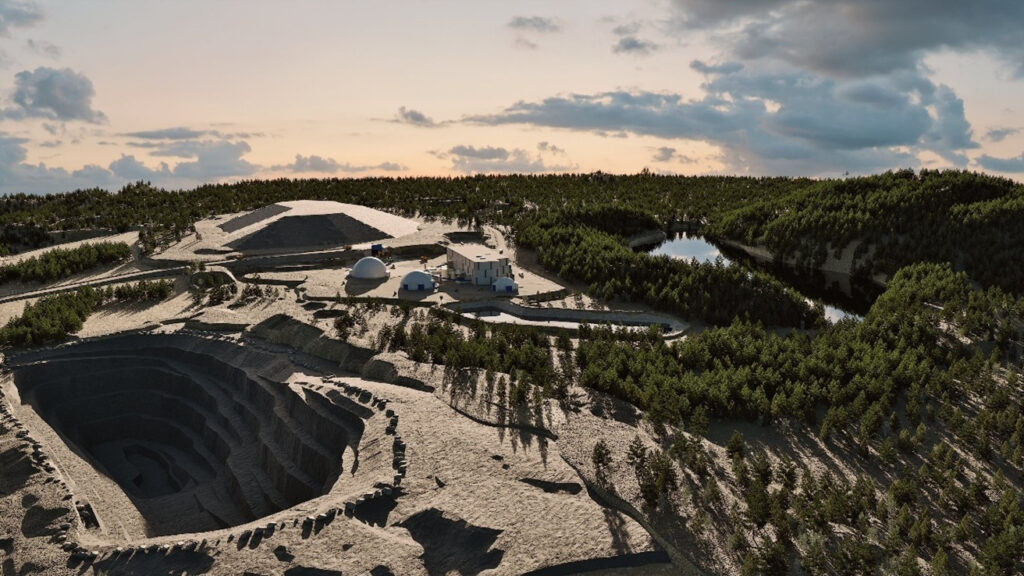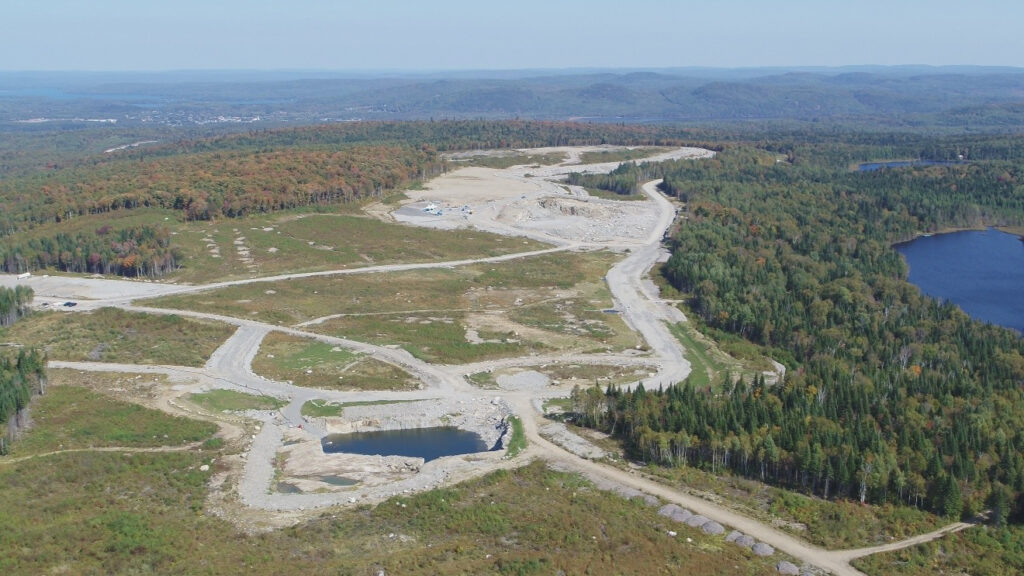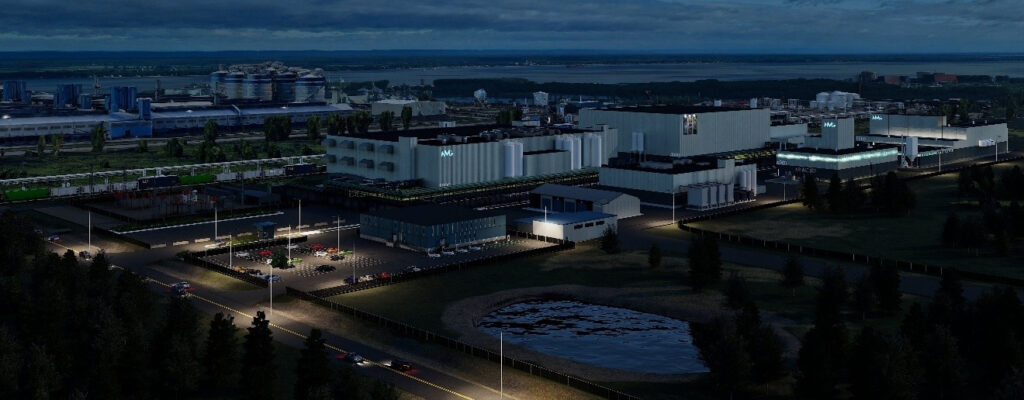
NMG Issues Updated Feasibility Study for its Integrated Phase-2 Ore-to-Active-Anode-Material Operations: the Matawinie Mine and the Bécancour Battery Material Plant
- Updated Feasibility Study covering NMG’s Phase-2 Matawinie Mine and the Bécancour Battery Material Plant for an integrated production of natural graphite and active anode material within a 150-km radius of Montréal, Québec, Canada.
- Integrated production model refined and updated in light of technological development, project optimizations, engineering advancement, and updated economic factors.
- Significant derisking with the adoption of the prevalent purification technology, aligned with established commercial operations worldwide.
- Updated Feasibility Study indicates an after-tax IRR of 17.5% and NPV of US$1,053 million with revenue reflective of third-party market projection of NMG’s offtakes with Panasonic and GM, and for the balance of production.
- Results confirm NMG’s Phase-2 technical and economic viability, enabling the Company to enter its project financing stage with a view to FID.
- Updated Feasibility Study to be presented to targeted lenders, Anchor Customers and institutional equity investors to advance and formalize the project financing and reach FID.
- Upon a positive FID, NMG’s Phase 2 Matawinie Mine and Bécancour Battery Material Plant could be built and enter commercial production within less than three years.
Nouveau Monde Graphite Inc. (NYSE: NMG) (TSX: NOU) issues the results of the Updated Technical Feasibility Study Report for the Matawinie Mine and Bécancour Battery Material Plant Integrated Graphite Projects carried out in accordance with the National Instrument 43-101. Conducted by BBA Inc. and various specialized consultants, the Updated Feasibility Study pulled from NMG’s 2022 Feasibility Study and updated key parameters in light of technological development, project optimizations, engineering advancement, and updated economic factors.
NMG’s integrated production model, covering the full value chain from mining to advanced processing, is designed to cater to the North American electric vehicle and energy storage market with a turnkey, local source of natural graphite active anode material. NMG has signed offtake agreements with Panasonic Energy Co., Ltd. a wholly owned subsidiary of Panasonic Holdings Corporation (TYO: 6752), and General Motors Holdings LLC, a wholly owned subsidiary of General Motors Co. (NYSE: GM), covering more than 80% of the Company’s planned Phase-2 production of active anode material.
Results of the Updated Feasibility Study indicate that NMG’s Phase 2 is technically feasible as well as economically viable. Upon a positive final investment decision, the Matawinie Mine and Bécancour Battery Material Plant could be built and enter commercial production within less than three years. Considering that its project financing, nearly 100% of its revenue, a significant amount of its capital expenditures and interest expenses are expected to be denominated in U.S. dollars, the Company has aligned the Updated Feasibility Study financial metrics with this currency, enabling a better representation of the underlying economic realities of the cash flows associated with this integrated project and the associated capital structure.
Arne H Frandsen, Chair of NMG, said: “The underlying driver for NMG’s ore-to-battery-material business is undeniable. While inflation, geopolitics, and trade dynamics create turbulences, we are focused on delivering on our mission to responsibly produce carbon-neutral advanced graphite materials to power the energy transition. Today’s results demonstrate the attractive operation that we have engineered within a stable jurisdiction and underpinned by high ESG principles to help North American manufacturers secure and reshore their supply chain.”
Eric Desaulniers, Founder, President, and CEO of NMG, declared: “We have been hard at work over the past months to examine, challenge, and refine every component of our future operations. The input of our Anchor Customers coupled with advanced precision through engineering, equipment specifications, procurement, and construction planning have enabled us to optimize our projected Phase-2 commercial production. We are confident that our plans will deliver a performing and competitive operation, supplying highly specialized products to our Anchor Customers. I am eager to present the results to our financial partners in view of FID.”
Integrated Production, From Ore to Battery Materials
Leveraging the Matawinie Mine production as feedstock for the Bécancour Battery Material Plant, NMG has developed an integrated material flowsheet to maximize the production of high-value active anode material destined to the battery market segments. Hence, the two facilities are set to operate in tandem to maximize operational efficiencies and margins along the value chain.
| Table 1: Economic Highlights of NMG’s Integrated Phase-2 Graphite Operations | |||||||
| ECONOMIC HIGHLIGHTS | Matawinie Mine | Bécancour Battery
Material Plant |
INTEGRATED
NMG MODEL |
||||
| Pre-tax NPV (8% discount rate) | US$402M | US$926M | US$1,328M | ||||
| After-tax NPV (8% discount rate) | US$252M | US$801M | US$1,053M | ||||
| Pre-tax IRR | 17.7% | 17.1% | 17.3% | ||||
| After-tax IRR | 16.0% | 18.0% | 17.5% | ||||
| Pre-tax payback | 5.5 years | 6.0 years | 5.8 years | ||||
| After-tax payback | 5.2 years | 5.0 years | 5.0 years | ||||
| Initial CAPEX | US$415M | US$911M | US$1,326M | ||||
| Annual OPEX | US$44M | US$124M | US$168M | ||||
| Costs reflect steady-state production, exclude the initial ramp-up period, and are based on normalized operations
The after-tax IRR exceeds the pre-tax IRR, driven by the favorable impact of eligible tax credits, such as the Canadian Clean Technology Manufacturing Investment Tax Credit, Zero-Emission Technology Manufacturing (ZETM) tax measures, provincial tax holidays for large investment projects and other available incentives. |
|||||||
Both greenfield projects, the Matawinie Mine and Bécancour Battery Material Plant were costed using test work results, Phase-1 operations, supplier quotations and consultants’ in-house databases. NMG and its consulting firms have refined design, engineering, and construction parameters to enable cost optimization. Furthermore, reserved blocks of Québec’s affordable clean hydropower underpins the Company’s operations, economics structure and carbon-neutrality commitment.
NMG’s integrated business model, with a secured feedstock, close-by operations at the western market’s doorstep and operational flexibility to adapt production based on demand, represents a stable and cost-effective structure in today’s everchanging macroeconomics.
The Company’s advanced processing capacities at the future Phase-2 Bécancour Battery Material Plant enable tailored production to unique customer specifications. The majority of the future Matawinie Mine production is set to be refined into active anode material, while a portion of jumbo and large high-purity flake graphite is set to be directed to specialty markets, with some flexibility in the allocation of volumes.
The Updated Feasibility Study incorporates NMG’s supply agreements with Panasonic Energy, GM and Traxys, as well as market studies by Benchmark Mineral Intelligence, a recognized, regulated and independent price reporting agency. NMG’s previously announced offtake agreements, which are subject to completion of conditions precedent and the project-related agreements, with its Anchor Customers provide visibility, pricing confidence, and reduced commercialization costs.
| Table 2: Commercialization Plans for NMG’s Integrated Phase-2 Production | ||||
| Products | Volume1 | Average Price | ||
| Flake graphite | 14,720 tpa | US$1,469/tonne | ||
| Active anode material | 44,100 tpa | US$9,346/tonne (Y1 to Y7)
US$10,402/tonne (Y8 to Y25) US$10,106/tonne (LOM average) |
||
| Micronized by-products | 43,334 tpa | US$400/tonne | ||
|
||||
Matawinie Mine
The Matawinie Mine remains largely the same as reflected in NMG’s previous technical report. The Updated Feasibility Study considers revised key parameters and costs, leveraging advancement in the project since the 2022 report, namely through detailed engineering, preparatory work at the site, key contracts awarded and/or negotiated, procurement planning, construction preparation, as well as optimization of operations between the two Phase-2 facilities.
The Matawinie graphite property, in which the Company owns a 100% interest, is located approximately 120 km as the crow flies north of Montréal, Québec, Canada, in Saint-Michel-des-Saints. The Tony Claim Block, part of the property, is composed of 159 exclusive exploration rights totaling 8,266 hectares. Since the deposit discovery, a comprehensive exploration program identified crystalline flake graphite mineralization, ultimately leading to the definition of Mineral Resources and Mineral Reserves (as presented below).
The Mineral Resources for the West Zone of the mining property is based on a total of 8,274 assay intervals collected from 27,888 m of core drilling and three surface trenches providing 207 channel samples. Proper quality control measures, including the insertion of duplicate, blank, and standard samples, were used throughout the exploration programs and returned within acceptable limits.
| Table 3: Current Pit-Constrained Mineral Resource Estimate for the West Zone | ||||||||||
| Mineral Resources Category1, 2 | Current Resources (March 25, 2025)5, 6, 7 | |||||||||
| Tonnage (Mt) | C(g) Grade (%)3 | Contained
Graphite (Mt) |
||||||||
| Measured | 28.5 | 4.28 | 1.22 | |||||||
| Indicated | 101.8 | 4.26 | 4.33 | |||||||
| Measured + Indicated | 130.3 | 4.26 | 5.55 | |||||||
| Inferred4 | 23.0 | 4.28 | 0.98 | |||||||
|
||||||||||
|
Table 4: Matawinie Mineral Reserve Estimate for the West Zone |
||||||||||
| Category | Tonnage (Mt) | C(g) Grade (%) | Contained
Graphite (Mt) |
|||||||
| Proven | 17.3 | 4.16 | 0.7 | |||||||
| Probable | 44.3 | 4.26 | 1.9 | |||||||
| Proven & Probable | 61.7 | 4.23 | 2.6 | |||||||
|
||||||||||
The future Matawinie Mine site is easily accessible via the dedicated access road that NMG built to connect to the local highway and is close to key infrastructure, including paved roads and high-voltage power lines, and the regional community, which provides a pool of workers and contractors. The project is in proximity to the Montréal metropolitan area, which also has skilled labor and many key suppliers.
Since 2015, multiple metallurgical process development and optimization programs have been carried out on samples from the Matawinie graphite mineralization zones. The programs focused on the development of a flowsheet that maximizes concentrate grade and recovery, while minimizing flake degradation. NMG has been operating the Phase-1 Matawinie Demonstration Plant since 2018 to help de-risking the process and produce graphite concentrate samples for customer evaluation and processing technological development. All components incorporated in the Matawinie Mine process are mature technologies.
With a 25-year life of mine, the Matawinie Mine will leverage the West Zone deposit for a nominal production of 105,882 tonnes per annum of graphite concentrate. The deposit will be mined using conventional open-pit mining methods consisting of drilling, blasting, loading, and hauling. To maximize the NPV, mining phases have been designed and incorporated into the mining plan to defer waste rock stripping and provide a balanced blended feed grade for the on-site concentrator over the LOM. Through crushing, milling, flotation, cleaning, and drying, the ore will be concentrated to attain 97.5% C(t).
Tailings produced at the concentrator will be segregated after the desulphurization circuit into low-sulphur content of non-acid generating tailings and a sulphide concentrate of potentially‑acid generating tailings. Both NAG and PAG will be filtered to reduce water content and then co-disposed with waste rock into deposition cells on a lined platform. The co‑deposition storage facility will be located at surface and as of Year 7, tailings and waste rocks will also be placed in the mined-out areas of the open pit. The deposit will be mined from south to north to ensure adequate space is available for in‑pit backfilling.
| Table 5: Operational and Economic Highlights of the Matawinie Mine | ||
| Parameters | ||
| LOM | 25 years | |
| Nominal annual processing rate | 2.56 M tonnes | |
| Stripping ratio (LOM) | 1.16:1 | |
| Average grade (LOM) | 4.23% C(g) | |
| Average mill recovery | 93% | |
| Nominal annual graphite concentrate production | 105,882 tonnes | |
| Finished product purity | 97.5% C(t) | |
| CAPEX | US$415M | |
| Annual OPEX | US$44M | |
| OPEX cost per tonne of graphite concentrate | US$419/tonne | |
| Costs reflect steady-state production, exclude the initial ramp-up period, and are based on normalized operations. | ||
A ministerial decree authorizing the Matawinie Mine (Decree # 47-2021) was granted by the Québec Government and all permits and authorizations pertaining to exploration, geotechnical, hydrogeological, and early preparatory works to date have been obtained.
Early works at the Matawinie Mine have included thus far tree clearing, construction of the nearly 8-km access road, preparation of the industrial pad, and civil works for environmental infrastructure. The site is considered concrete-ready for the start of construction upon a positive FID, with a number of key contracts having been awarded, including process equipment, the dedicated powerline and the electrical substation.
Bécancour Battery Material Plant
The Phase-2 Bécancour Battery Material Plant is planned as a comprehensive advanced processing platform set to receive Matawinie graphite concentrate production for refining and commercial distribution. Plans for this facility have been substantially revised using inputs from NMG’s Phase-1 operations, technology development, and engineering.
Approximately 150 km northeast of Montréal on the Saint Lawrence River, in the heart of Québec’s “battery valley”, NMG’s Bécancour site is located adjacent to its Phase-1 purification plant, within an established industrial park. The site provides robust local infrastructure with a direct supply of chemicals from nearby producers, affordable hydroelectricity, multimodal logistics (international deep-sea port, railway, and expressway) and a regional pool of skilled workforce.
The future Bécancour Battery Material Plant will regroup shaping, purification and coating capacities to produce battery-grade active anode material.
The shaping process, essentially a mechanical transformation, reduces the flake size (micronization) and rounds graphite material (spheronization) to increase the density of the spherical graphite for battery use. At its Phase-1 facility, NMG has already assimilated and refined this process, and tested different equipment to inform the engineering of the Phase-2 plant. Shaping generates a micronized graphite by-product to be sold.
Purification removes impurities from the spheronized graphite to bring the product to ≥99.90% carbon content. Following testing at its Phase-1 Purification Plant plus third-party sites, trade-off analyses and process optimization, NMG has selected the prevalent chemical purification technology for its future Phase-2 Bécancour Battery Material Plant. Commercial operations worldwide have demonstrated the performance and efficiency of this technology in line with battery manufacturers’ requirements; thus, reducing the technological risks for the project. Continued optimization of the process to refine environmental performance, operational, and financial parameters along with sample production are being carried out at partnering facilities to support detailed engineering and commercialization efforts.
The coating aims at enhancing the electrochemical performance of active anode material in lithium-ion batteries. To establish the proper technology, precursor type and process parameters, NMG performed different studies and tests at its Phase-1 facility, in independent laboratories and at suppliers’ test facilities. Most technologies selected are being widely used in the industry, further reducing technological risks.
| Table 6: Operational and Economic Highlights of the Bécancour Battery Material Plant | ||
| Parameters | ||
| Annual active anode material production | 44,100 tonnes | |
| Finished product purity | ≥99.90% C(t) | |
| CAPEX | US$911M | |
| Annual OPEX | US$124M | |
| OPEX cost per tonne of active anode material | US$2,810/tonne | |
| Annual micronized graphite by-product production | 43,334 tpa | |
| Costs reflect steady-state production, exclude the initial ramp-up period, and are based on normalized operations. | ||
In preparation for the launch of construction, preliminary works – tree clearing, on-site road construction, site grading – were carried out in 2024.
Responsible Production & ESG
In line with its environmental, social and governance practices, NMG plans to build and operate an integrated production that promotes stewardship throughout its value chain. The Company strives to prevent and limit potential impacts through the introduction of responsible practices including co-disposal dry stacking of tailings, progressive reclamation of the Matawinie site, strategy for the electrification of its operations, water recycling, greenhouse gas reduction measures, and active stakeholder engagement at every stage of project development. NMG has signed a collaboration and benefit-sharing agreement with the Municipality of Saint-Michel-des-Saints as well as an impact and benefit agreement with the Atikamekw First Nation of Manawan.
NMG is committed to pursuing its efforts to improve its practices, technologies, products, and procurement as it advances the detailed engineering, construction, commissioning, and launch of commercial production. The Company strives to maximize opportunities for Indigenous and local workers, contractors, and communities throughout the project execution.
Next Steps and Quality Assurance
The confirmation of NMG’s Phase-2 viability through the Updated Feasibility Study enables the Company to enter its project financing stage with a view to reach FID.
There is no certainty that the economic forecasts on which the Updated Feasibility Study is based will be realized. There are a number of risks and uncertainties identifiable to any new project and usually cover the mineralization, process, financial, environment and permitting aspects. Following an analysis of the major risks to the projects, a P50 management risk reserve of US$122M is recommended. This reserve is not included in the capital cost estimate but is within the range of the financial sensitivity analysis of the capital cost. The top risks are: 1) The optimization of the water treatment process technology; 2) The efficient integration of key Asian suppliers into the project detailed engineering and construction; and 3) The qualification by the customers of the product from the Matawinie Mine and the Bécancour Battery Material Plant.
A sensitivity analysis reveals that the viability of the Projects will not be significantly vulnerable to variations in capital and operating costs within the margins of error associated with the Updated Feasibility Study estimates. However, the viability of the Projects remains more vulnerable to the USD/CAD exchange rate and the larger uncertainty in future market prices.
Scientific and technical information presented in this press release was reviewed and approved by André Allaire, P.Eng. (BBA), Yann Camus, P.Eng. (SGS Geological Services) and Jeffrey Cassoff, P.Eng. (BBA), Qualified Persons as defined under NI 43-101.
The Updated Feasibility Study will be filed on SEDAR+ at www.sedarplus.ca, EDGAR at www.sec.gov and on the Company’s website at www.NMG.com within 45 days of this press release. Readers are encouraged to read the Study in its entirety, including all qualifications, assumptions and exclusions that relate to the details summarized in this press release. The Study is intended to be read as a whole, and sections should not be read or relied upon out of context.
About Nouveau Monde Graphite
Nouveau Monde Graphite is an integrated company developing responsible mining and advanced processing operations to supply the global economy with carbon-neutral active anode material to power EV and renewable energy storage systems. The Company is developing a fully integrated ore-to-battery-material source of graphite-based active anode material in Québec, Canada. With recognized ESG standards and structuring partnerships with anchor customers, NMG is set to become a strategic supplier to the world’s leading lithium-ion battery and EV manufacturers, providing advanced materials while promoting sustainability and supply chain traceability.
Rendering of the Phase-2 Matawinie Mine set to produce ~106,000 tpa of flake graphite.
Aerial view of the Matawinie Mine site in September 2024.
Rendering of the Phase-2 Bécancour Battery Material Plant, in the heart of the Bécancour industrial park set to produce ~44,000 tpa of active anode material.
MORE or "UNCATEGORIZED"
Doubleview Extends High-Grade Domains at Hat: H099 Returns 438m of 0.40% CuEq Including 52m of 1.02% CuEq, Expanding Mineralization Envelope Around Conceptual Pit Vertically and Laterally
Doubleview Gold Corp. (TSX-V: DBG) (OTCQB: DBLVF) (FSE: 1D4) is pleased to announce assay results f... READ MORE
Cosa Closes Upsized C$7.5 Million Private Placement
Cosa Resources Corp. (TSX-V: COSA) (OTCQB: COSAF) (FSE: SSKU) is pleased to announce that it ... READ MORE
Americas Gold and Silver Closes US$132.25 Million Bought Deal Financing
Americas Gold and Silver Corporation (TSX: USA) (NYSE American: USAS) is pleased to report that it h... READ MORE
1911 Gold Closes C$23 Million "Best Efforts" Life Offering & Private Placement and Provides Corporate Updates
1911 Gold Corporation (TSX-V: AUMB) (FRA: 2KY) is pleased to announce that it has completed its prev... READ MORE
Endeavour Silver Completes US$350 Million Offering of Convertible Senior Notes
Endeavour Silver Corp. (NYSE: EXK) (TSX: EDR) announced today the closing of its previously announce... READ MORE
















